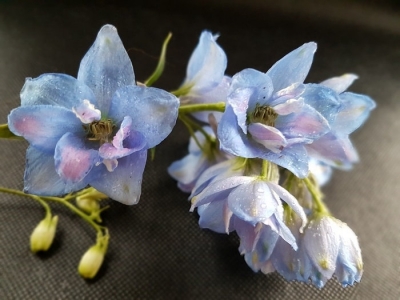How to Grow Larkspur Flowers

If you’ve tried to grow delphiniums without success, you might try larkspur flowers instead. Larkspurs (Consolida ajacis) are annual cousins of delphiniums, which are perennials.
Whereas delphiniums need cool temperatures, ideal soil moisture and plenty of babying, larkspurs are tough, hardy and resilient. Larkspurs are similar to delphiniums in that they have a vertical form, green feathery foliage and clusters of pink, blue or white flowers that form on their stalks from early spring to summer.
Larkspurs were first introduced to England in the 16th century from Italy. They thrived there and were instantly popular. Early colonists brought them to America, where they became a mainstay in colonial gardens.
Planting Larkspur
Larkspurs are among the easiest annuals to grow. Sow them in the garden in early spring – or fall in warm climates. They tolerate most soils, but grow best in light, well-draining soil. Amend heavy soils first with compost or manure.
Plant larkspurs in full sun and keep the soil slightly moist. They need less moisture than delphiniums, but they don’t bloom well in hot, dry conditions. Plant them with other native and cottage flowers, such as coneflowers, black-eyed Susans, coreopsis, lavender or daisies.
Larkspurs grow quickly, reaching 3 feet in one season. The whispy stems may need staking, especially in windy weather. One common problem with larkspurs is that they readily self-sow. In fact, you may only need to plant them once and they’ll come up year after year. If they become invasive, though, remove the spent flowers and pull up any unwanted volunteers.
Wild larkspur is sometimes seen as a nuisance, particularly in fields where livestock forage, because the plants are poisonous and can be fatal. In some areas, ranchers may experience death losses due to the ingestion of larkspur of up to 15 percent, according to Utah State University. In the home garden, it’s important to note that seeds of ornamental larkspurs are poisonous. Grow the plants away from children and pets.
Larkspur Pests and Problems
Larkspurs are subject to many of the same problems delphiniums experience – slugs, snails, powdery mildew and root rot. To combat all these problems, use soaker hoses, rather than overhead sprinklers and keep the soil slightly moist, but not soggy. Set snail traps to deter snails and slugs. Powdery mildew can be treated with fungicides, but the problem is merely a cosmetic one that usually appears in the hot, oppressive weather of late summer. Cut down severely infected plants and discard them.
Like delphiniums, larkspurs can become pouty in the heat of summer. If they turn brown, cut them down, but leave a few plants and flower heads in place to repopulate the garden next summer.
Larkspur Cultivars Worth Trying
‘Cloudy Skies’ is a mix that includes blue, purple, white and silver flowers. The plants grow 3 feet tall.
‘Imperial’ larkspurs reach 4 feet tall and produce purple, blue, pink and white flowers.
‘Sublime’ produces 4 feet tall stalks with a profusion of blooms.
Có thể bạn quan tâm
Phần mềm

Phối trộn thức ăn chăn nuôi

Pha dung dịch thủy canh

Định mức cho tôm ăn

Phối trộn phân bón NPK

Xác định tỷ lệ tôm sống

Chuyển đổi đơn vị phân bón

Xác định công suất sục khí

Chuyển đổi đơn vị tôm

Tính diện tích nhà kính

Tính thể tích ao hồ




 How To Dry Herbs From the Garden
How To Dry Herbs From the Garden  How to Grow Torenia
How to Grow Torenia